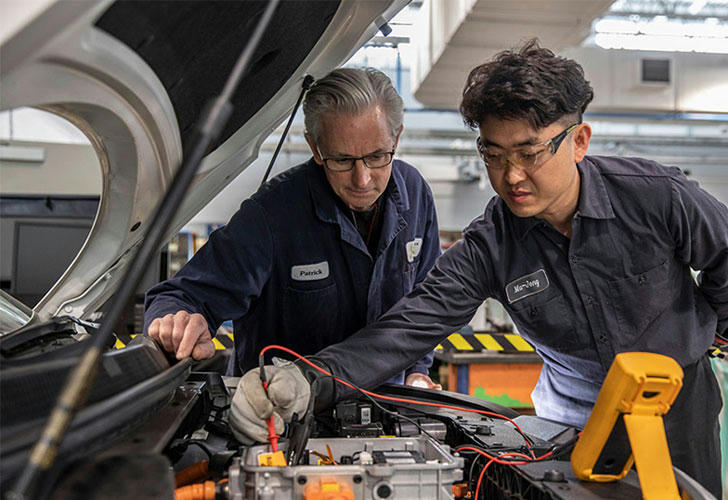Gear Up for Success: Top Auto Mechanic Training Courses in 2025
Dreaming of turning wrenches and diagnosing engines like a pro? Auto mechanic training courses open the garage door to a rewarding career—whether you aim to join a dealership, start your own shop, or simply keep your ride humming smoothly. In this friendly guide, we’ll explore why 2025 is the perfect time to enroll, what makes a course great, and the must-have tools you’ll use from day one.

1. Why Pursue Auto Mechanic Training in 2025?
High Demand & Stability – With newer, more complex vehicles rolling off assembly lines, skilled technicians are in hot demand.
Great Earnings – Entry-level techs start with competitive wages and bonuses; master technicians command even higher pay.
Hands-On Learning – Courses combine classroom theory with real-world garage practice, so you’re ready to tackle brake systems, electronics, and overhauls.
Career Pathways – Certifications (ASE, manufacturer-specific) pave the road to supervisory roles, specialty niches (electrical, diagnostics), or independent shop ownership.
If you love problem-solving and working with your hands, there’s never been a better time to accelerate your journey from car enthusiast to certified professional.
2. Picking the Right Course
Not all programs are created equal. Here’s what to look for:
- Accreditation & ASE Prep – Ensure the school’s curriculum aligns with ASE certification tests, so you graduate ready to pass those exams.
- Modern Equipment – Look for courses that use up-to-date diagnostic scanners, EV training rigs, and fuel-injection simulators—mirroring real-world shop environments.
- Experienced Instructors – Veteran technicians who’ve seen every engine glitch make the best teachers. Check for instructor certifications and shop backgrounds.
- Flexible Learning Options – Hybrid programs blend online theory with weekend or evening shop labs—ideal if you’re balancing work or family commitments.
- Job Placement Support – Top schools partner with local dealerships and repair chains to help grads land their first gig.
Whether you aim for a full diploma program or a short-form specialty course, matching the curriculum to your goals ensures you get maximum value and employability.
3. Core Skills You’ll Master
Your training will cover a broad spectrum of automotive systems. Key modules include:
3.1 Engine Fundamentals
- Internal Combustion Theory: Understand four-stroke cycles, compression ratios, and fuel mixtures.
- Engine Repair: Disassembly, inspection, and re-assembly of cylinder heads, crankshafts, and camshafts.
3.2 Brakes & Suspension
- Brake Systems: From drum and disc brakes to anti-lock (ABS) diagnostics and repair.
- Suspension & Steering: Alignments, shock absorbers, struts, and power steering maintenance.
3.3 Electrical & Diagnostics
- Circuit Analysis: Using multimeters and scan tools to trace shorts, voltage drops, and sensor faults.
- ECU Programming: Flashing updates and calibrations for modern engine control units.
3.4 Drivetrain & Transmission
- Manual & Automatic: Clutch adjustments, fluid changes, solenoid testing, and transmission rebuild basics.
- Driveshaft & Differential: U-joint servicing and gear ratio understanding.
3.5 HVAC & Comfort Systems
- Air Conditioning: Refrigerant handling, leak detection, compressor replacement.
- Heating & Ventilation: Blend door actuators and blower motor repairs.
Mastering each system requires both theory and hands-on drills—exactly what a quality auto mechanic course delivers.
4. Setting Up Your Home Practice Area
While nothing replaces a fully equipped shop, you can sharpen essential skills at home:
- Workstand or Engine Stand: Mount a small engine or transmission for practice outside the lab.
- Basic Hand Tools: Metric & SAE socket sets, combination wrenches, screwdrivers, and pliers.
- Digital Multimeter: A must-have for electrical troubleshooting and sensor checks.
- Portable Scan Tool: Entry-level OBD-II reader lets you practice code reading and clearing on your personal vehicle.
- Service Manual or Repair Database Subscription: OEM specs, torque charts, and wiring diagrams at your fingertips.
Having this gear at home means every lecture can turn into an impromptu lab session, reinforcing what you learn in class.
5. Safety Gear & Shop Essentials
Safety first! Protect yourself with:
- Mechanic’s Gloves: Cut-resistant, oil-grip gloves keep your hands safe and clean.
- Safety Glasses or Goggles: Barrier protection against flying debris, brake dust, and chemicals.
- Hearing Protection: Earplugs or earmuffs during loud tasks like grinding or impact wrench use.
- Shop Rags & Cleaning Solvent: Keep your workspace tidy—clean tools and parts before reassembly.
- Fire Extinguisher & First-Aid Kit: Every home garage should have these for emergencies.
Quality safety gear is non-negotiable. Courses stress proper PPE and safe shop practices—embrace them from day one.
Conclusion
Enrolling in an auto mechanic training course in 2025 sets you on the fast track to a fulfilling, hands-on career—repairing, diagnosing, and maintaining modern vehicles. By choosing an accredited program, gathering essential tools, and following safety best practices, you’ll move confidently from student to skilled technician.
Ready to power up your future? Sign up for a course, build your toolkit with the recommended gear above, and shift your passion for cars into a high-octane profession.
Happy wrenching!
